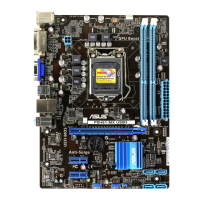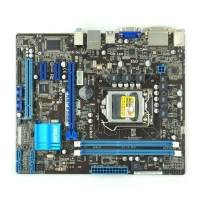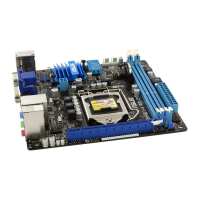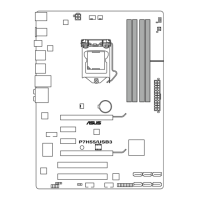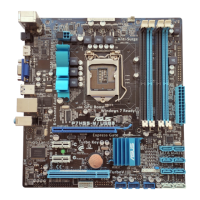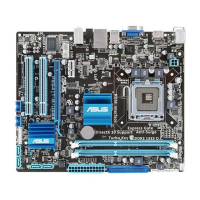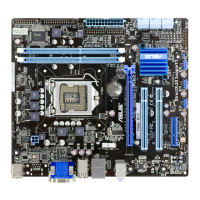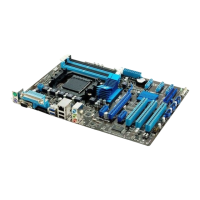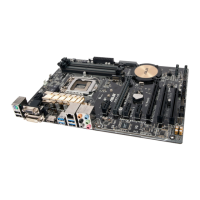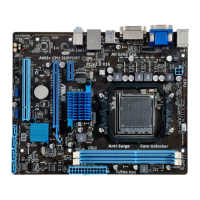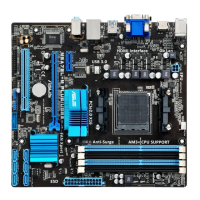Do you have a question about the Asus P8H61-M2 USB3 and is the answer not in the manual?
FCC compliance statement for Class B digital devices, detailing interference conditions.
Statement regarding digital apparatus compliance with Canadian radio noise emission limits.
Information on ASUS's commitment to environmental protection through product recycling programs.
Guidelines to prevent electric shock hazards and ensure safe handling of electrical components.
Instructions for safe installation, handling, and operation of the motherboard and components.
Explains how the user guide is structured into chapters and sections for clarity.
Details symbols and typography used to convey warnings, cautions, and important information.
Lists additional resources like ASUS websites for product updates and optional documentation.
Pre-installation precautions, handling components, and understanding the standby power LED.
Details the physical layout, placement direction, and screw hole locations on the motherboard.
Step-by-step guide for installing the CPU, heatsink, and fan, including safety measures.
Information on DDR3 DIMM sockets, memory configurations, and installation/removal procedures.
Describes PCI Express slots and their compatibility for expansion cards.
Explains the function and location of jumpers like CLRTC and various board connectors.
Covers operating system compatibility and information regarding the support DVD contents.
Instructions for updating BIOS using ASUS utilities like Update, EZ Flash, and CrashFree.
How to enter and navigate the BIOS setup utility, including EZ Mode and Advanced Mode.
Configuration options for system language, date, time, and security settings in the BIOS.
Details on adjusting memory frequency, CPU settings, and voltage for overclocking.
Settings for CPU, system agent, PCH, SATA, USB, and onboard devices.
Displays system temperature, voltage, and fan speed, with fan control options.
Configuration of system boot priorities, NumLock state, and boot behavior.
Access to utilities like EZ Flash, SPD Information, and O.C. Profile for BIOS management.
Options to save/discard changes, load defaults, or exit the BIOS setup.
FCC compliance statement for Class B digital devices, detailing interference conditions.
Statement regarding digital apparatus compliance with Canadian radio noise emission limits.
Information on ASUS's commitment to environmental protection through product recycling programs.
Guidelines to prevent electric shock hazards and ensure safe handling of electrical components.
Instructions for safe installation, handling, and operation of the motherboard and components.
Explains how the user guide is structured into chapters and sections for clarity.
Details symbols and typography used to convey warnings, cautions, and important information.
Lists additional resources like ASUS websites for product updates and optional documentation.
Pre-installation precautions, handling components, and understanding the standby power LED.
Details the physical layout, placement direction, and screw hole locations on the motherboard.
Step-by-step guide for installing the CPU, heatsink, and fan, including safety measures.
Information on DDR3 DIMM sockets, memory configurations, and installation/removal procedures.
Describes PCI Express slots and their compatibility for expansion cards.
Explains the function and location of jumpers like CLRTC and various board connectors.
Covers operating system compatibility and information regarding the support DVD contents.
Instructions for updating BIOS using ASUS utilities like Update, EZ Flash, and CrashFree.
How to enter and navigate the BIOS setup utility, including EZ Mode and Advanced Mode.
Configuration options for system language, date, time, and security settings in the BIOS.
Details on adjusting memory frequency, CPU settings, and voltage for overclocking.
Settings for CPU, system agent, PCH, SATA, USB, and onboard devices.
Displays system temperature, voltage, and fan speed, with fan control options.
Configuration of system boot priorities, NumLock state, and boot behavior.
Access to utilities like EZ Flash, SPD Information, and O.C. Profile for BIOS management.
Options to save/discard changes, load defaults, or exit the BIOS setup.
| Form Factor | Micro ATX |
|---|---|
| Socket | LGA 1155 |
| Chipset | Intel H61 |
| Memory Slots | 2 |
| Maximum Memory | 16 GB |
| Memory Type | DDR3 |
| USB 3.0 Ports | 2 |
| USB 2.0 Ports | 8 |
| SATA 3Gb/s Ports | 4 |
| PCI Express 3.0 x16 | 1 |
| PCI Express x1 | 2 |
| Audio Chipset | Realtek ALC887 |
| LAN Chipset | Realtek 8111E |
| Max. LAN Speed | 10/100/1000 Mbps |
| PS/2 | 1 |
| Onboard Video | Yes |
| Onboard LAN | Yes |
| Memory Standard | DDR3 1333/1066 MHz |
| Dimensions (W x L) | 24.4 cm |
| Power Pin | 24-pin ATX |
